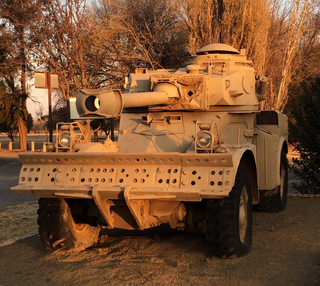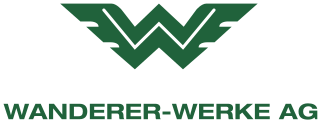This page is based on this
Wikipedia article Text is available under the
CC BY-SA 4.0 license; additional terms may apply.
Images, videos and audio are available under their respective licenses.

A military armored car is a lightweight wheeled armored fighting vehicle, historically employed for reconnaissance, internal security, armed escort, and other subordinate battlefield tasks. With the gradual decline of mounted cavalry, armored cars were developed for carrying out duties formerly assigned to horsemen. Following the invention of the tank, the armored car remained popular due to its comparatively simplified maintenance and low production cost. It also found favor with several colonial armies as a cheaper weapon for use in underdeveloped regions. During World War II, most armored cars were engineered for reconnaissance and passive observation, while others were devoted to communications tasks. Some equipped with heavier armament could even substitute for tracked combat vehicles in favorable conditions—such as pursuit or flanking maneuvers during the North African Campaign.

Studebaker was an American automobile manufacturer based in South Bend, Indiana. Founded in 1852 and incorporated in 1868 as the Studebaker Brothers Manufacturing Company, the firm was originally a producer of wagons for farmers, miners, and the military.

The Royal Mews is a mews of the British Royal Family. In London the Royal Mews has occupied two main sites, formerly at Charing Cross, and since the 1820s at Buckingham Palace. The site is open to the public throughout much of the year.

A trailer is an unpowered vehicle towed by a powered vehicle. It is commonly used for the transport of goods and materials.

Wanderer [ˈvandəʀɐ] was a German manufacturer of bicycles, motorcycles, automobiles, vans and other machinery. Established as Winklhofer & Jaenicke in 1896 by Johann Baptist Winklhofer and Richard Adolf Jaenicke, the company used the Wanderer brand name from 1911, making civilian automobiles until 1941 and military vehicles until 1945.

A coachbuilder or body-maker manufactures bodies for passenger-carrying vehicles. Coachwork is the body of an automobile, bus, horse-drawn carriage, or railroad passenger car. The word "coach" was derived from the Hungarian town of Kocs.

amit

Daimler Motoren Gesellschaft (DMG) was a German engineering company and later automobile manufacturer, in operation from 1890 until 1926. Founded by Gottlieb Daimler and Wilhelm Maybach, it was based first in Cannstatt. Daimler died in 1900, and their business moved in 1903 to Stuttgart-Untertürkheim after the original factory was destroyed by fire, and again to Berlin in 1922. Other factories were located in Marienfelde and Sindelfingen.

A buckboard is a four-wheeled wagon of simple construction meant to be drawn by a horse or other large animal. The "buckboard" is the front-most board on the wagon that could act as both a footrest for the driver and protection for the driver from the horse's rear hooves in case of a "buck". The buckboard is steered by its front wheels, which are connected by a single axle. The front and rear axle are connected by a platform of one or more boards to which the front axle is connected on a pivoting joint at its midpoint. A buckboard wagon often carries a seat for a driver. Such a seat may be supported by springs. The main platform between axles is not suspended by springs like a carriage. Made in the 18th century around the same time as carriages.

Sheffield Tramway was an extensive tramway network serving the English city of Sheffield and its suburbs.
Södertelje Verkstäder was a Swedish company in Södertälje that made railway cars and Draisine. In 1901 the builder of electric cars Harald Håkansson managed to agree a contract so that Södertelje Verkstäder got access to experience, blueprints and engines from Kühlstein, NAG and Protos that they sold under the name "Helios". Starting in 1902 the company also imported the Oldsmobile Curved Dash lookalike Northern from Detroit, USA and sold it as "Norden". However, the market wasn't ready for automobiles and in 1906 they sold the remaining stock but continued making railway cars and aeroplanes.

A car is a wheeled motor vehicle used for transportation. Most definitions of car say they run primarily on roads, seat one to eight people, have four tires, and mainly transport people rather than goods.

The Upper Douglas Cable Tramway was a tram line serving all points between the southern end of the promenade and the upper part of the town of Douglas in the Isle of Man. It opened on 15 August 1896 and closed on 19 August 1929.

The Antwerp tramway network is a network of tramways forming part of the public transport system in Antwerp, a city in the Flemish region of Belgium. The network is operated by the Flemish region's transportation company De Lijn. As of April 2017, it featured fourteen lines, eight of which pass partially underground.

Buggy is generally used to refer to any lightweight automobile with off road capabilities and sparse bodywork. Most are built either as a kit car or from scratch.

The Peugeot Type 27 is an early motor vehicle produced between 1899 and 1902 by the French auto-maker Peugeot at their Audincourt plant. Only 29 were produced. This automobile had a brougham car body, similar to the older brougham carriage.

Dundee and District Tramways operated a tramway service in Dundee between 1877 and 1899.
The Stirling and Bridge of Allan Tramway was a tramway between Stirling and Bridge of Allan from 1874 to 1920.

The Berlin Motor Show originally started in 1897 in the German capital Berlin as the home of the International Motor Show and ran until 1939. From 1951 the IAA eventually became established in Frankfurt.
Bradford Corporation Tramways were a tramway network in the city of Bradford, West Riding of Yorkshire, England which operated trams from 1882 until 1950 and trolleybuses from 1911 until 1972. The track gauge of the tramways was 4 ft.


















